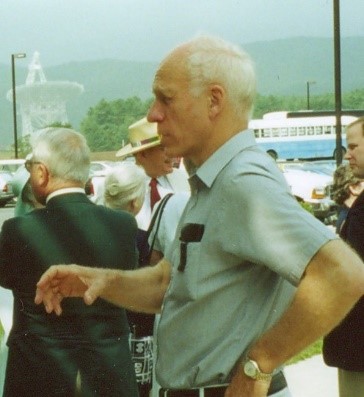 Phil Kronberg at the 2001 dedication of the Green Bank Telescope (Photo courtesy of Richard Wielebinski
Phil Kronberg at the 2001 dedication of the Green Bank Telescope (Photo courtesy of Richard Wielebinski
Philipp Paul Kronberg
Contributed by Richard Wielebinski
Philipp Paul Kronberg was born on Friday, January 13th 1939 in Ottawa, Ontario. The family moved to Vantleek Hill, Ontario, where Philip attended the Vantleek Hill College. He went on to receive degrees from the Queen's University (B.Sc., M.Sc.). In Queen's University Phil was involved in Engineering work. His career begun in reactor technology at the Atomic Energy of Canada (Chalk River Lab.). Phil moved to the University of Manchester (1966-1968) where he obtained first the Ph.D., degree and later was honored by the D.Sc. degree. He later joined the Department of Astronomy and Physics of the University of Toronto (1969-2002) and became the Orson Anderson Scholar at the Los Alamos National Laboratory (2002-2003).
In addition to his home base Phil became involved in numerous visiting appointments around the world. Starting in 1978 Phil held several visiting appointments at the Max-Planck-Institut für Radioastronomie, Bonn. He was awarded a Guggenheim Fellowship (1984), a Kililam Foundation Fellowship, and the Humboldt Prize in 2007, and spent periods as distinguished Visiting Scientist at CSIRO and the University of Sydney. He was elected as a Fellow of the American Physical Society.
Phil's astronomical interests can best be described under the heading: 'Cosmic Magnetic Fields.' Radio astronomy in the 1960s confirmed the existence of cosmic magnetic fields by radio polarization observations. In the 1970s the observations of rotation measure added a second method of studying magnetic fields. The early work of Phil Kronberg with J.F.C Wardle led to a large catalogue of rotation measures of radio sources. The continuation of these studies, in collaboration with M. Simard-Normandin, led to the early models of the Galactic magnetic field. Numerous publications came with detailed analysis of magnetic fields in active galaxies like M82, clusters of galaxies, and X-ray sources. Important theoretical publications came with the interpretation of the cause of magnetic fields in cosmic objects.
In view of his extensive experience in Engineering, Phil was often invited to serve on committees that dealt with new projects in astronomy. He served on major scientific committees of organizations in Canada, the USA and UK. In the USA, it included committees of the NSF, AUI, NRAO and others. He was the chairman of the NRAO VLA advisory committee and on the scientific strategy and design committee of the Green Bank Telescope.
In 1980s Phil played a major role in establishing the Cray XMP-based supercomputer centre. He was the chairman of the evaluation panel for the Sudbury Neutrino Observatory and was a Governing Council member of the National Research Council of Canada. In this role he became a member of the management board of the James Clerk Maxwell Submillimeter Telescope. He was also active in the planning group of the AUGER detector project in Argentina.
Since 2002 Phil was an invited visiting scholar in the Los Alamos National Laboratory. In 2004 he became Professor Emeritus in residence at the University of Toronto. He travelled often, giving advice to many researchers, around the globe. He did this in a very effective way, always available to help in cases of questions. Phil Kronberg died on 13th January 2023 in Ottawa, Ontario.
![[IAU logo]](iau_wb_thumb.jpg)
![[URSI logo]](URSI-logo-thumb.jpg)
![[Karl Jansky at his antenna]](jansky_photo_02_thumb.jpg)
![[Reber's Wheaton antenna]](Reber_Telescope_Wheaton_thumb.jpg)
![[Dover Heights]](Dover_Heights_02_thumb.jpg)
![[4C telescope]](GB61-195_4C_telescope_thumb.jpg)
![[Ewen and horn antenna]](ewen_horn1s.jpg)
![[Dwingeloo, 1956]](Dwingeloo-1956-thumb.jpg)
![[Jocelyn Bell Burnell and Cambridge antenna used in pulsar discovery]](burnell2_thumb.jpg)
![[Lovell Telescope at Jodrell Bank]](site_1594_0001-500-334-20180316163019-thumb150.jpg)
![[Wilson, Penzias, and Bell Labs horn antenna]](wilson-penzias-horn_thumb.jpg)
![[6-m Millimeter Radio Telescope in Mitaka, Japan]](6m-thumb.jpg)

